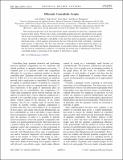| dc.contributor.author | Gokler, Can | |
| dc.contributor.author | Thompson, Kevin | |
| dc.contributor.author | Lloyd, Seth | |
| dc.contributor.author | Shor, Peter Williston | |
| dc.date.accessioned | 2017-06-28T13:26:38Z | |
| dc.date.available | 2017-06-28T13:26:38Z | |
| dc.date.issued | 2017-06 | |
| dc.date.submitted | 2015-11 | |
| dc.identifier.issn | 0031-9007 | |
| dc.identifier.issn | 1079-7114 | |
| dc.identifier.uri | http://hdl.handle.net/1721.1/110346 | |
| dc.description.abstract | We investigate graphs that can be disconnected into small components by removing a vanishingly small fraction of their vertices. We show that, when a controllable quantum network is described by such a graph and the gaps in eigenfrequencies and in transition frequencies are bounded exponentially in the number of vertices, the network is efficiently controllable, in the sense that universal quantum computation can be performed using a control sequence polynomial in the size of the network while controlling a vanishingly small fraction of subsystems. We show that networks corresponding to finite-dimensional lattices are efficiently controllable and explore generalizations to percolation clusters and random graphs. We show that the classical computational complexity of estimating the ground state of Hamiltonians described by controllable graphs is polynomial in the number of subsystems or qubits. | en_US |
| dc.publisher | American Physical Society | en_US |
| dc.relation.isversionof | http://dx.doi.org/10.1103/PhysRevLett.118.260501 | en_US |
| dc.rights | Article is made available in accordance with the publisher's policy and may be subject to US copyright law. Please refer to the publisher's site for terms of use. | en_US |
| dc.source | American Physical Society | en_US |
| dc.title | Efficiently Controllable Graphs | en_US |
| dc.type | Article | en_US |
| dc.identifier.citation | Gokler, Can; Lloyd, Seth; Shor, Peter and Thompson, Kevin. "Efficiently Controllable Graphs." Physical Review Letters 118, 260501 (June 2017): 1-5 © 2017 American Physical Society | en_US |
| dc.contributor.department | Massachusetts Institute of Technology. Department of Mathematics | en_US |
| dc.contributor.department | Massachusetts Institute of Technology. Department of Mechanical Engineering | en_US |
| dc.contributor.mitauthor | Lloyd, Seth | |
| dc.contributor.mitauthor | Shor, Peter Williston | |
| dc.relation.journal | Physical Review Letters | en_US |
| dc.eprint.version | Final published version | en_US |
| dc.type.uri | http://purl.org/eprint/type/JournalArticle | en_US |
| eprint.status | http://purl.org/eprint/status/PeerReviewed | en_US |
| dc.date.updated | 2017-06-27T22:00:05Z | |
| dc.language.rfc3066 | en | |
| dc.rights.holder | American Physical Society | |
| dspace.orderedauthors | Gokler, Can; Lloyd, Seth; Shor, Peter; Thompson, Kevin | en_US |
| dspace.embargo.terms | N | en_US |
| dc.identifier.orcid | https://orcid.org/0000-0003-4626-5648 | |
| mit.license | PUBLISHER_POLICY | en_US |
